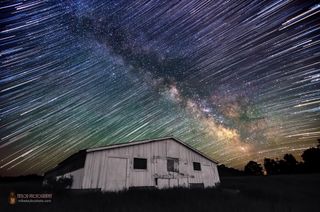
A veteran astrophotographer in Maine took advantage of a clear night sky in rural Maine to capture two beautiful images of our host galaxy, the Milky Way.
"Living in rural Maine offers me some great opportunities to capture the beauty of our night sky with mostly very little light pollution. This spot at the top of a ridge in the small town of Palermo is a great example," photographer Mike Taylor wrote SPACE.com in an email. "On this particular night there was quite a show of green airglow in the sky and a just a bit of yellow/orange glow from nearby towns on the horizon."
The first photo is a single image capture, while the second image is a composite of 81 frames from a static time lapse of the Milky Way Galaxy in the night sky. Taylor stacked the frames of this sequence to make a standard star trails image and then blended/masked in a single frame of the Milky Way. The processing was done with Lightroom 4 and Photoshop CS5. He used a Nikon D7000 camera, Tokina 11-16mm at 11mm, f/2.8, 25 seconds, ISO 1600 on June 10, 2013 to capture the images.

Our host galaxy, the Milky Way, is a barred spiral galaxy seen as a band of light in the night sky. It stretches between 100, 000 and 120,000 light-years in diameter. It is estimated that the galaxy has approximately 400 billion stars. At the center of our galaxy lies a gigantic black hole billions of times the size of the sun.
Editor's note: If you have an amazing night sky photo you'd like to share for a possible story or image gallery, please contact managing editor Tariq Malik at spacephotos@space.com.
Follow SPACE.com on Twitter @Spacedotcom. We're also on Facebook & Google+.
Get the Space.com Newsletter
Breaking space news, the latest updates on rocket launches, skywatching events and more!
Join our Space Forums to keep talking space on the latest missions, night sky and more! And if you have a news tip, correction or comment, let us know at: community@space.com.
Nina Sen is a freelance writer and producer who covered night sky photography and astronomy for Space.com. She began writing and producing content for Space.com in 2011 with a focus on story and image production, as well as amazing space photos captured by NASA telescopes and other missions. Her work also includes coverage of amazing images by astrophotographers that showcase the night sky's beauty.
